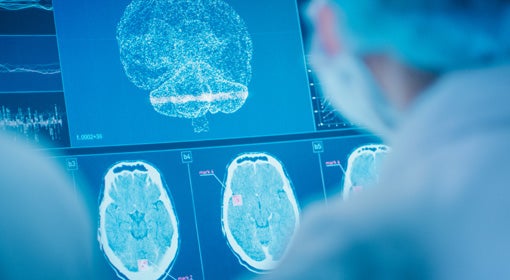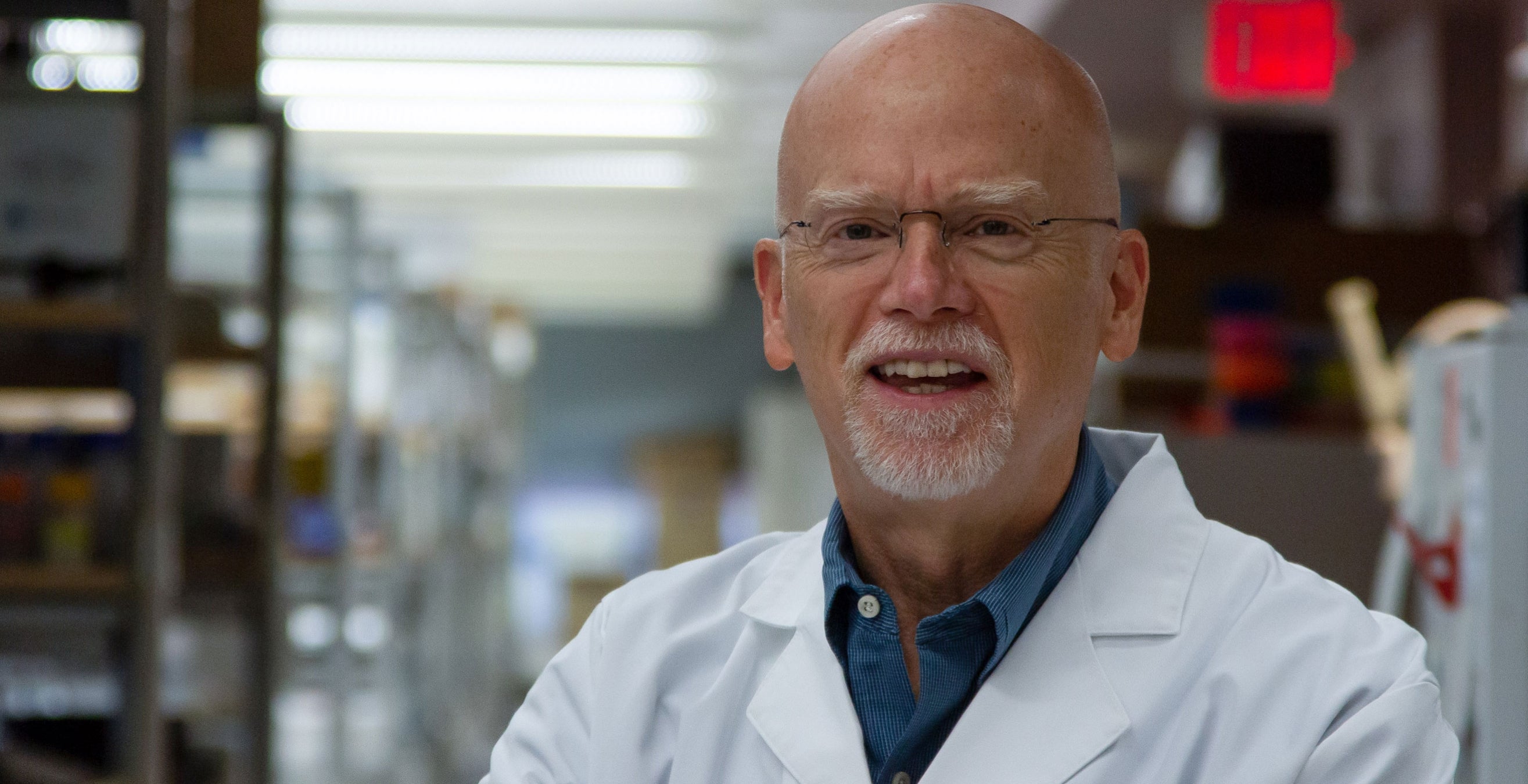The neurology lab is quiet. Graduate student and postdoctoral researchers are deep in thought as they work below shelves of books, bottles and beakers. Suddenly, the door pops open and Tim Greenamyre strides in with cheerful anticipation.
“What’s the latest breakthrough?” the professor teasingly demands of the group. The students smile at the optimistic ritual. Who knows? This could be the day they elicit one of his “Holy s—, this worked!” moments of excitement.
“What keeps me motivated is finding out new things, seeing experimental results hot off the press,” says Greenamyre, Love Family Professor, vice-chair of Pitt’s neurology department and director of the Pittsburgh Institute for Neurodegenerative Diseases at the University. “When we get a tantalizing new result, even if it’s something completely unexpected, it really drives me. Some of the most exciting stuff we’ve done has been when an experiment ‘didn’t work,’ but ended up telling us something completely new.
“Sitting down at the microscope with my students and postdocs is the best part of my day.”
It’s just that infectious enthusiasm and out-of-the-box thinking that has allowed Greenamyre to lead a career of groundbreaking discovery in the realm of Parkinson’s disease (PD). Through his research, he’s developed a clearer picture of PD, identified environmental toxins that can contribute to the disease, established a widely used model to explore experimental PD treatments and zeroed in on new ways to ease patients’ symptoms. He’s also built a reputation for being an instrumental mentor to young scientists as well as a caring, thoughtful doctor.
In recognition of his career, he was recently awarded the 2022 Michael J. Fox Foundation’s Robert A. Pritzker Prize for Leadership in Parkinson’s Research, given to researchers who make “exceptional contributions to PD research and mentoring.”
“Dr. Greenamyre has trailblazed an important and enduring legacy in Parkinson’s research,” says Todd Sherer, the foundation’s chief mission officer and one of Greenamyre’s former mentees. “Maybe most importantly though, he’s never lost sight of why we study PD. I’ll always remember working in Dr. Greenamyre’s lab and him telling us the patients needed better understanding and treatments. He’s done so much over the years to deliver for those people.”
What keeps me motivated is finding out new things, seeing experimental results hot off the press.
Tim Greenamyre
Parkinson’s is a progressive neurological disease in which brain cells that make dopamine, a chemical that controls movement, stop working or die. Affecting more than 10 million people worldwide, its symptoms include worsening tremors, stiffness, impaired balance and coordination, depression, and memory and sleep difficulties. With no cure for PD, doctors can only treat these symptoms. And despite immense progress in the past 20 years, many patients’ symptoms are not well controlled, especially in later stages of the disease. Greenamyre, however, is determined to find a way to arrest or stop the illness itself.
“If we could just slow the disease by 50% in somebody recently diagnosed, they would have great quality of life for the natural duration and Parkinson’s would be a minor annoyance rather than a life-threatening disease,” he says.
Greenamyre made his first momentous discovery early in his career after reviewing reports of Parkinson’s patients exhibiting a defect in a mitochondrial enzyme. At the time, few researchers believed there was anything left to learn about mitochondria; they were the energy producers of cells, and that was it. But the young researcher wondered if mitochondria play a larger role than anyone suspected.
He says he had “kind of a far-fetched idea” to test this theory by attempting to model the defective enzyme in rats using a chemical called rotenone, a mitochondrial enzyme inhibitor and pesticide. Coincidentally, researchers were just beginning to consider pesticides as a possible risk factor to developing PD. Greenamyre’s hunch proved right. He was able to reproduce a Parkinson’s-like disease, establishing the central roles of mitochondria and environmental toxin exposure in PD. Researchers now understand most PD cases are due to the interaction of genetic makeup and a lifetime of environmental exposures.
Greenamyre brought his trailblazing work to Pitt in 2005, impressed by the University and eager for the opportunity to “wear two hats,” leading both the new neurodegenerative diseases research facility and the clinical division of movement disorders. These roles allow him to see patients and continue his work in the lab alongside his graduate and postdoctoral researchers.
“I’ve been here going on 17 years now,” he says. “Of the patients that I first diagnosed — some have died. All have progressed. It’s a long-term relationship that you develop with your patients and their families. They give me a different perspective and a sense of urgency.”
Today, Greenamyre continues to rely on the rotenone model, finding it not only accurately reproduces features of PD but also predicts previously unknown elements of the disease in humans. Critically, it has more recently allowed Greenamyre and others to test experimental therapeutics to treat the disease or halt its progression.
And the discoveries keep coming.
One of the most recent breakthrough moments Greenamyre and his dedicated team enjoyed came when they discovered that two genes, which when mutated cause rare genetic forms of PD, also play crucial roles in environmental toxin-induced parkinsonism. Their research into these genes and their interactions with toxins implies that therapeutic approaches currently in development for rare genetic cases may be useful to nearly all PD patients. Some of these therapeutics are now in human clinical trial.
With developments like these, Greenamyre remains hopeful for the future.
“We know the genes that are involved, some of the environmental risk factors and how they act to cause cell death,” he says.
“I think for the first time, we’re really getting to the heart of what’s causing the disease and causing it to progress, and I’m really optimistic that we’ll have things that could slow or halt Parkinson’s.”
Breakthroughs in the Making at Pitt
 Dollars for Dreams
Dollars for Dreams
Good sleep has big benefits for college students — including better academic performance and increased physical and mental health — but they are among the least likely age group to get enough. Pitt researchers may have found a way to address that conundrum. In a recent study, Associate Professor Osea Giuntella and colleagues found students go to sleep earlier and get more sleep when they are paid to get their z’s. The effects lasted even after the incentives stopped. Now that researchers know students can be encouraged to alter their sleeping habits, they plan to see whether other, more practical incentives work just as well as cash.
 Under Pressure
Under Pressure
Patients who need continuous blood pressure monitoring often face restless nights as their cuff-based devices inflate every 15 minutes, rousing them from sleep and potentially altering results. To make monitoring more comfortable for patients and more accurate for researchers, Feng Xiong, associate professor of electrical and computer engineering, is developing a comfier, cuffless monitoring device inspired by the ultrasticky toe pads of the gecko. The National Institute of Health has awarded Xiong and his team $580,000 to further explore the innovation.
 Helpful Headband
Helpful Headband
Most of the body’s vital signs can be quickly and easily checked at a doctor’s office with nothing more than a stethoscope and a blood pressure cuff. But measuring a patient’s brain pressure (which may be necessary following conditions such as an infection or head injury) typically requires lengthy, invasive or painful procedures — until now. Michael McDowell, an assistant professor of neurological surgery at the School of Medicine, has helped test a headband that uses near-infrared light to measure the changes in brain pressure in real time. The technology, recently chronicled in the Journal of Neurosurgery, could turn a risky procedure into a routine assessment and improve outcomes for patients suffering from conditions such as concussions and stroke.
This story was published on January 26, 2023. It is part of Pitt Magazine's Winter '23 issue.

